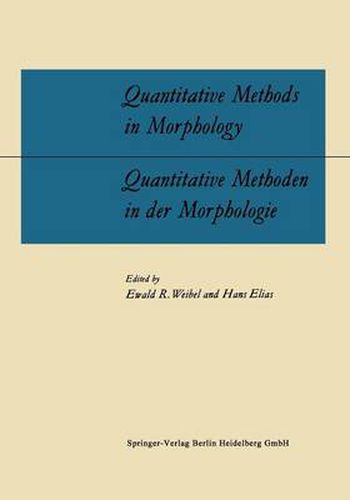Readings Newsletter
Become a Readings Member to make your shopping experience even easier.
Sign in or sign up for free!
You’re not far away from qualifying for FREE standard shipping within Australia
You’ve qualified for FREE standard shipping within Australia
The cart is loading…






This title is printed to order. This book may have been self-published. If so, we cannot guarantee the quality of the content. In the main most books will have gone through the editing process however some may not. We therefore suggest that you be aware of this before ordering this book. If in doubt check either the author or publisher’s details as we are unable to accept any returns unless they are faulty. Please contact us if you have any questions.
Stereologic techniques begin to play an increasing role in biologic morphology, particularly there where correlation of structure and function on a quantitative basis is sought. These powerful methods have been in use for many years - partly even for many decades - in geology, mineralogy and metallurgy, while attempts to introduce them into histology have remained rather rare until a few years ago. In order to stimulate discussion among anatomists about stereo logic methods the International Society for Stereology, an interdisciplinary society, organized a Sym posium on Quantitative Methods in Morphology which took place on August 10, 1965 in the framework of the Eighth International Congress of Anatomists in Wiesbaden, Germany. The papers presented at this symposium are published in this volume in slightly extended form. Some of the papers of this volume are of rather specialized nature and presume a basic knowledge of stereology. The first chapter on general stereological principles has therefore been considerably extended and short introductory review paragraphs have been added to a few subsequent chapters to help those who are not yet familiar with this new field in understanding the more specialized original articles. Long discussion periods formed an essential part of the symposium. However, they were conducted very informally and hence it would not have been profitable to reproduce them in extenso, particularly since the major results of discussion have been incorporated by the authors into the expanded manuscripts presented here.
$9.00 standard shipping within Australia
FREE standard shipping within Australia for orders over $100.00
Express & International shipping calculated at checkout
This title is printed to order. This book may have been self-published. If so, we cannot guarantee the quality of the content. In the main most books will have gone through the editing process however some may not. We therefore suggest that you be aware of this before ordering this book. If in doubt check either the author or publisher’s details as we are unable to accept any returns unless they are faulty. Please contact us if you have any questions.
Stereologic techniques begin to play an increasing role in biologic morphology, particularly there where correlation of structure and function on a quantitative basis is sought. These powerful methods have been in use for many years - partly even for many decades - in geology, mineralogy and metallurgy, while attempts to introduce them into histology have remained rather rare until a few years ago. In order to stimulate discussion among anatomists about stereo logic methods the International Society for Stereology, an interdisciplinary society, organized a Sym posium on Quantitative Methods in Morphology which took place on August 10, 1965 in the framework of the Eighth International Congress of Anatomists in Wiesbaden, Germany. The papers presented at this symposium are published in this volume in slightly extended form. Some of the papers of this volume are of rather specialized nature and presume a basic knowledge of stereology. The first chapter on general stereological principles has therefore been considerably extended and short introductory review paragraphs have been added to a few subsequent chapters to help those who are not yet familiar with this new field in understanding the more specialized original articles. Long discussion periods formed an essential part of the symposium. However, they were conducted very informally and hence it would not have been profitable to reproduce them in extenso, particularly since the major results of discussion have been incorporated by the authors into the expanded manuscripts presented here.